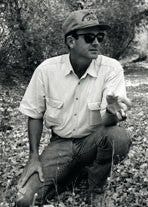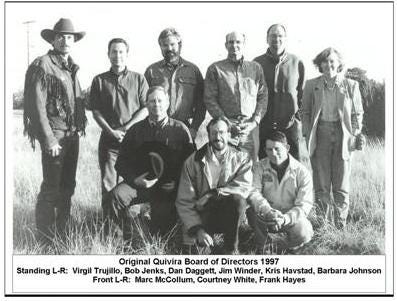Welcome to Terra Firma by Courtney White. I’ve spent my life prospecting for innovative, practical, and collaborative answers to pressing problems involving land and people, sharing them with others. I’d like to share them with you!
Don’t miss the next issue, sign up here:
In the previous two issues, I discussed regenerative agriculture, one of the most hopeful developments I’ve come across. A huge challenge to its adoption, however, is the persistence of entrenched paradigms – such as an unquestioned belief in tilling – and an unwillingness to consider new approaches.
In this newsletter, I will discuss my experience in creating dialogue between ranchers and conservationists in the West, two groups with very entrenched beliefs historically. I learned it starts with what we can agree on: in this case, soil, grass, and water!

Let me begin by saying the current political and cultural environment is very different than it was when I began my collaborative conservation work in 1997. The divides are wider and deeper today: urban and rural, red and blue, Democrat and Republican, liberal and conservative, to name a few. But things were pretty antagonistic back then too with groups hunkered down in their respective trenches and not willing to lower their fists to talk together about, well, much of anything.
Fast forward and there’s a great deal of collaborative, productive, positive dialogue going on between former adversaries all across the region today. The reason is simple: people decided they were willing to focus on shared interests rather than continue to argue our differences. This attitude came to be called the radical center – a term coined by Arizona rancher Bill McDonald, who cofounded and led the Malpai Borderlands Group, one of the earliest and most effective collaborative groups in the West.
I’ll come back to the radical center in the next newsletter. Right now I want to focus on how dialogue got started between ranchers and conservationists. There were two linked parts: (1) a common vision for the land; and (2) the ground below our feet, literally.
When I became active with the Sierra Club in 1995, land use in the American West was perceived by many as a zero-sum game: one side could advance only as far the other side retreated. A football game is a good analogy. The “environmentalist” team believed it could only advance downfield if the “rancher” team was driven back. This attitude was represented by two popular bumper stickers at the time: “Cattle-Free in ’93!” shouted one. “Cattle Galore in ’94!” shouted the other.
In zero-sum thinking, there’s not a lot of room for dialogue. Fortunately, I met three people who taught me there was an entirely different way of looking at the land and the world – a rancher, an environmentalist, and a poet.

The rancher was Jim Winder, whose family place is located near Nutt, in southern New Mexico. At the time, the conflict over public lands ranching had reached a fever pitch and Jim decided to join the Sierra Club in order to find out what it was that environmentalists wanted. It was a brave decision. It made him an outcast in the ranching community nearly as much as did his public support for the reintroduction of the Mexican wolf.
What also impressed me about Jim was his knowledge about the land. He knew more about the environment than any environmentalist I knew, myself included. Jim talked with enthusiasm about grass, soil microbes, the nutrient cycle, photosynthesis, carbon cycling, decomposition, water, and wildlife. It was the vocabulary, I soon realized, of the common ground below our feet. It was also a vocabulary that could be shared regardless of our political and social beliefs. Very cool!
The environmentalist was Dan Dagget, who lived in Flagstaff, Arizona. Dan understood that the fight with ranchers was ‘lose-lose’ for everyone who cared about the American West. In the early 1990s, he decided to participate in an exploratory peace-making process called Six-Six (six ranchers and six activists). At a meeting, the facilitator asked each person to write down their vision for the West. When they compared notes, Dan was stunned to learn their visions were exactly the same: open space, healthy ecosystems, abundant wildlife, and plentiful water.
That’s when he realized ranchers and environmentalists could get along. It started with a vision that we had in common.
The poet was Rumi – a thirteenth-century Persian mystic. He wrote a line of poetry that hit me like a ton of bricks during this period of time: “Out beyond ideas of rightdoing and wrongdoing is a field. I’ll meet you there.” That’s exactly what I wanted to do - go to that field, wave our arms, and see who joined us.
Think about that quote in the context of American politics today!
In 1997, myself, Jim Winder, and Barbara Johnson decided to give common ground a chance by founding the Quivira Coalition. Here is the original Board of Directors: three ranchers, three conservationists, and three federal land mangers, including the lead scientist at the USDA’s Jornada Experimental Range:

In my many years of work in collaborative conservation that followed, I learned over and over that we have more in common than in difference if we are willing to talk first about what unites us. In our case, the land united us. Ranchers, conservationists, scientists, agency personnel, members of the public – we discovered that we all loved to talk about soil, grass, and water! Why is this land healthy? What’s causing that soil erosion over there? What species is this grass? How do we get more of it to grow?
We were helped in our common work by a shared belief in facts. The range science community produced a number of important documents and protocols for measuring land health objectively which became a cornerstone in our conversations. Literally, the ‘parts’ of the land (the presence or absence of erosion, for example) became the basis for dialogue between parties. We measured things together on the ground and then we discussed what we had documented. We could, and did, argue about how to manage the land but we based our opinions on actual data. I can’t emphasize this enough. We must be willing to agree on basic facts!
We were also united in our opposition to activities that compromised the health of the land: real estate subdivisions, oil-and-gas development, unchecked erosion, and the deleterious effects of too much tourism.
Food united us too. This realization came later – and I’ll talk about it in a future newsletter. I am convinced that land and food are the things that hold us together as a society. We all love to eat, of course, but we are also fascinated by food no matter who we are, where we come from, what our political and religious beliefs are, or what socioeconomic group we belong to. We all love food.
These things are still true today, more so than ever. Land and food are our common ground, now and always, if we would just take the time to look and see.
That’s what Terra Firma is all about: looking at the world in a positive way, grounded in nature, experience, facts, and hope.
Resources:
Here’s a history book about the rise of collaborative conservation at the time: Across the Great Divide, edited by Philip Brick and Don Snow. 2000 (2nd ed). https://www.amazon.com/Across-Great-Divide-Explorations-Collaborative/dp/1559638117
Here’s the book that started it all. It’s available and still a great read: Beyond the Rangeland Conflict by Dan Dagget, 2000 (reprint). https://www.amazon.com/Beyond-Rangeland-Conflict-Toward-Works/dp/0966622901
For land nerds, here’s the book that began the scientific consensus that brought people together: Rangeland Health by the National Research Council, 1994. https://www.nap.edu/catalog/2212/rangeland-health-new-methods-to-classify-inventory-and-monitor-rangelands
Here’s a chapter I wrote in Conservation for a New Generation titled “Land Health: A Language to Describe the Common Ground Beneath Our Feet.” It describes the vocabulary of land in detail. http://jcourtneywhite.com/wp-content/uploads/2016/09/Land_Health.pdf
For those of you not familiar with ranching, I highly recommend a new book titled Cowboy Is a Verb: Notes from a Modern-day Rancher by Richard Collins, who is a leader in the collaborative conservation movement in southern Arizona. https://www.amazon.com/Cowboy-Verb-Notes-Modern-day-Rancher/dp/1948908239
Video:
Here’s a 4-minute video about the importance of data in rangeland management: https://www.sare.org/Newsroom/Press-Releases/New-Video-Improving-the-Management-of-Rangeland-Ecosystems
Here’s an hour-long homemade recording of a lecture that Dan Dagget gave about cows and land: https://www.youtube.com/watch?v=nYnNDTPuQhU
Here’s a dynamic philosophical talk about the stubbornness of paradigms by Ray Archuleta, a soil scientist and regenerative agriculture evangelist: https://www.youtube.com/watch?v=rLHZNNd0pAc
Web Site
A leader in collaborative conservation and the radical center today is the Western Landowners Alliance: https://westernlandowners.org/

Thank you for reading this issue of my newsletter. It is published every Thursday morning – for free! Please consider sharing it with a friend or two or three. My goal is to reach as many people as possible!
About me: For twenty years I worked to create a radical center among ranchers, conservationists, agencies and others focused on western working landscapes. My nonfiction books include Forewords by Wendell Berry and Michael Pollan. For more information or to contact me see: www.jcourtneywhite.com/
I am also the author of a MYSTERY series called the Sun Ranch Saga, set on a working cattle ranch in northern New Mexico. The first book, titled The Sun, is available and I’m working on the sequel. See: http://jcourtneywhite.com/fiction/
Terra Firma means ‘solid earth’ or ‘firm ground’ in contrast to air or water. Historically, it was first used by the Republic of Venice to describe its holdings on the Italian mainland.


